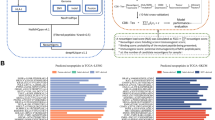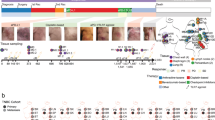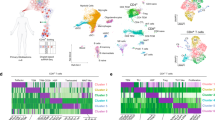Abstract
Neoantigens are the key targets of antitumor immune responses from cytotoxic T cells and play a critical role in affecting tumor progressions and immunotherapy treatment responses. However, little is known about how the interaction between neoantigens and T cells ultimately affects the evolution of cancerous masses. Here, we develop a hierarchical Bayesian model, named neoantigen–T cell interaction estimation (netie) to infer the history of neoantigen-CD8+ T cell interactions in tumors. Netie was systematically validated and applied to examine the molecular patterns of 3,219 tumors, compiled from a panel of 18 cancer types. We showed that tumors with an increase in immune selection pressure over time are associated with T cells that have an activation-related expression signature. We also identified a subset of exhausted cytotoxic T cells postimmunotherapy associated with tumor clones that newly arise after treatment. These analyses demonstrate how netie enables the interrogation of the relationship between individual neoantigen repertoires and the tumor molecular profiles. We found that a T cell inflammation gene expression profile (TIGEP) is more predictive of patient outcomes in the tumors with an increase in immune pressure over time, which reveals a curious synergy between T cells and neoantigen distributions. Overall, we provide a new tool that is capable of revealing the imprints left by neoantigens during each tumor’s developmental process and of predicting how tumors will progress under further pressure of the host’s immune system.
This is a preview of subscription content, access via your institution
Access options
Access Nature and 54 other Nature Portfolio journals
Get Nature+, our best-value online-access subscription
$29.99 / 30 days
cancel any time
Subscribe to this journal
Receive 12 print issues and online access
$259.00 per year
only $21.58 per issue
Buy this article
- Purchase on Springer Link
- Instant access to full article PDF
Prices may be subject to local taxes which are calculated during checkout




Similar content being viewed by others
Data availability
The baseline patients come from TCGA and the patients with kidney cancer from our previous study21. The TCGA data (expression, mutation and survival) were downloaded from the TCGA firehose website (https://gdac.broadinstitute.org/,version of 2016012800.0.0). TCGA HLA typing data were provided by Thorsson et al.55. For the treatment cohorts, we gathered 32 patients with gastric cancer from Cristescu et al.42 and Kim et al.45; eight patients with NSCLC from Anagnostou et al.46; 105 patients with HNSCC from Cristescu et al.42; 352 patients with melanoma from Cristescu et al.42, Hugo et al.5, Liu et al.47, Riaz et al.6 and Van Allen et al.48; and 157 patients with RCC from IMmotion150 cohort49 and Miao et al.7. Information on access to data is provided in these original reports. The in-house MDACC patients’ raw genomic data have been uploaded into the European Genome-Phenome Archive (EGA) with the accession numbers EGAD00001008382 and EGAD00001008482. The accession codes and links for each dataset are listed in Supplementary Table 4. Source data are provided with this paper.
Code availability
The netie R package is available at https://github.com/tianshilu/Netie with Apache license version v.2.0.
References
Lu, T. et al. Tumor neoantigenicity assessment with CSiN score incorporates clonality and immunogenicity to predict immunotherapy outcomes. Sci. Immunol. 21, eaaz3199 (2020).
Hsiehchen, D. et al. DNA repair gene mutations as predictors of immune checkpoint inhibitor response beyond tumor mutation burden. Cell Rep. Med. 1, 100034 (2020).
Chung, A. S. et al. Immune checkpoint inhibition is safe and effective for liver cancer prevention in a mouse model of hepatocellular carcinoma. Cancer Prev. Res. 13, 911–922 (2020).
Lu, T. et al. Deep learning-based prediction of the T cell receptor-antigen binding specificity. Nat. Mach. Intell. 3, 864–875 (2021).
Hugo, W. et al. Genomic and transcriptomic features of response to anti-PD-1 therapy in metastatic melanoma. Cell 165, 35–44 (2016).
Riaz, N. et al. Tumor and microenvironment evolution during immunotherapy with Nivolumab. Cell 171, 934–949.e16 (2017).
Miao, D. et al. Genomic correlates of response to immune checkpoint therapies in clear cell renal cell carcinoma. Science 359, 801–806 (2018).
Hellmann, M. D. et al. Genomic features of response to combination immunotherapy in patients with advanced non-small-cell lung cancer. Cancer Cell. 33, 843–852.e4 (2018).
Matsushita, H. et al. Neoantigen load, antigen presentation machinery, and immune signatures determine prognosis in clear cell renal cell carcinoma. Cancer Immunol. Res. 4, 463–471 (2016).
Miller, A. et al. High somatic mutation and neoantigen burden are correlated with decreased progression-free survival in multiple myeloma. Blood Cancer J. 7, e612 (2017).
Matsushita, H. et al. The frequency of neoantigens per somatic mutation rather than overall mutational load or number of predicted neoantigens per se is a prognostic factor in ovarian clear cell carcinoma. Oncoimmunology 6, e1338996 (2017).
Gettinger, S. et al. Impaired HLA class I antigen processing and presentation as a mechanism of acquired resistance to immune checkpoint inhibitors in lung cancer. Cancer Discov. 7, 1420–1435 (2017).
Sato, Y. et al. Integrated molecular analysis of clear-cell renal cell carcinoma. Nat. Genet. 45, 860–867 (2013).
Jiang, T. et al. Tumor neoantigens: from basic research to clinical applications. J. Hematol. Oncol. 12, 93 (2019).
Blass, E. & Ott, P. A. Advances in the development of personalized neoantigen-based therapeutic cancer vaccines. Nat. Rev. Clin. Oncol. 18, 215–229 (2021).
Li, S. et al. Characterization of neoantigen-specific T cells in cancer resistant to immune checkpoint therapies. Proc. Natl Acad. Sci. USA 27, 118 (2021).
Roth, A. et al. PyClone: statistical inference of clonal population structure in cancer. Nat. Methods 11, 396–398 (2014).
Deshwar, A. G. et al. PhyloWGS: reconstructing subclonal composition and evolution from whole-genome sequencing of tumors. Genome Biol. 16, 35 (2015).
Miller, C. A. et al. SciClone: inferring clonal architecture and tracking the spatial and temporal patterns of tumor evolution. PLoS Comput. Biol. 10, e1003665 (2014).
Łuksza, M. et al. A neoantigen fitness model predicts tumour response to checkpoint blockade immunotherapy. Nature 551, 517–520 (2017).
Wang, T. et al. An empirical approach leveraging tumorgrafts to dissect the tumor microenvironment in renal cell carcinoma identifies missing link to prognostic inflammatory factors. Cancer Discov. 8, 1142–1155 (2018).
Subramanian, A. et al. Gene set enrichment analysis: a knowledge-based approach for interpreting genome-wide expression profiles. Proc. Natl Acad. Sci. USA 102, 15545–15550 (2005).
Yi, J. S., Cox, M. A. & Zajac, A. J. T-cell exhaustion: characteristics, causes and conversion. Immunology 129, 474–481 (2010).
Mehta, A. K., Gracias, D. T. & Croft, M. TNF activity and T cells. Cytokine 101, 14–18 (2018).
Anderson, A. C. Tim-3, a negative regulator of anti-tumor immunity. Curr. Opin. Immunol. 24, 213–216 (2012).
Yang, Z.-Z. et al. Expression of LAG-3 defines exhaustion of intratumoral PD-1+ T cells and correlates with poor outcome in follicular lymphoma. Oncotarget 8, 61425–61439 (2017).
Zhang, B. et al. Nidogen-1 expression is associated with overall survival and temozolomide sensitivity in low-grade glioma patients. Aging 13, 9085–9107 (2021).
Yang, C. et al. Transcriptomic analysis identified ARHGAP family as a novel biomarker associated with tumor-promoting immune infiltration and nanomechanical characteristics in bladder cancer. Front Cell Dev. Biol. 9, 657219 (2021).
Feng, Q., Li, L., Li, M. & Wang, X. Immunological classification of gliomas based on immunogenomic profiling. J. Neuroinflammation 17, 360 (2020).
Griffin, G. K. et al. Epigenetic silencing by SETDB1 suppresses tumour intrinsic immunogenicity. Nature 595, 309–314 (2021).
Lyu, X., Li, G. & Qiao, Q. Identification of an immune classification for cervical cancer and integrative analysis of multiomics data. J. Transl. Med. 19, 200 (2021).
Chen, X., Su, C., Ren, S., Zhou, C. & Jiang, T. Pan-cancer analysis of KEAP1 mutations as biomarkers for immunotherapy outcomes. Ann. Transl. Med. 8, 141 (2020).
Biton, J. et al. TP53, STK11, and EGFR mutations predict tumor immune profile and the response to Anti-PD-1 in lung adenocarcinoma. Clin. Cancer Res. 24, 5710–5723 (2018).
Xie, Z. et al. Gene set knowledge discovery with Enrichr. Curr. Protoc. 1, e90 (2021).
Voronov, E. & Apte, R. N. Targeting the tumor microenvironment by intervention in interleukin-1 biology. Curr. Pharm. Des. 23, 4893–4905 (2017).
Dinarello, C. A. in Textbook of Autoinflammation (eds Hashkes, P. J. et al.) 711–725 (Springer, 2019).
Dang, H. X. et al. ClonEvol: clonal ordering and visualization in cancer sequencing. Ann. Oncol. 28, 3076–3082 (2017).
Liu, B. et al. Temporal single-cell tracing reveals clonal revival and expansion of precursor exhausted T cells during anti-PD-1 therapy in lung cancer. Nat. Cancer 3, 108–121 (2022).
Barnes, T. A. & Amir, E. HYPE or HOPE: the prognostic value of infiltrating immune cells in cancer. Br. J. Cancer 118, e5 (2018).
Melero, I., Rouzaut, A., Motz, G. T. & Coukos, G. T-cell and NK-cell infiltration into solid tumors: a key limiting factor for efficacious cancer immunotherapy. Cancer Discov. 4, 522–526 (2014).
Zuo, S., Wei, M., Wang, S., Dong, J. & Wei, J. Pan-cancer analysis of immune cell infiltration identifies a prognostic Immune-Cell Characteristic Score (ICCS) in lung adenocarcinoma. Front Immunol. 11, 1218 (2020).
Cristescu, R. et al. Pan-tumor genomic biomarkers for PD-1 checkpoint blockade-based immunotherapy. Science 12, 362 (2018).
Şenbabaoğlu, Y. et al. Tumor immune microenvironment characterization in clear cell renal cell carcinoma identifies prognostic and immunotherapeutically relevant messenger RNA signatures. Genome Biol. 17, 231 (2016).
O’Donnell, T. J., Rubinsteyn, A. & Laserson, U. MHCflurry 2.0: improved pan-allele prediction of MHC class I-presented peptides by incorporating antigen processing. Cell Syst. 11, 418–419 (2020).
Kim, S. T. et al. Comprehensive molecular characterization of clinical responses to PD-1 inhibition in metastatic gastric cancer. Nat. Med. 24, 1449–1458 (2018).
Anagnostou, V. et al. Evolution of neoantigen landscape during immune checkpoint blockade in non-small cell lung. Cancer Discov. 7, 264–276 (2017).
Liu, D. et al. Integrative molecular and clinical modeling of clinical outcomes to PD1 blockade in patients with metastatic melanoma. Nat. Med. 25, 1916–1927 (2019).
Van Allen, E. M. et al. Genomic correlates of response to CTLA-4 blockade in metastatic melanoma. Science 350, 207–211 (2015).
McDermott, D. F. et al. Clinical activity and molecular correlates of response to atezolizumab alone or in combination with bevacizumab versus sunitinib in renal cell carcinoma. Nat. Med. 24, 749–757 (2018).
Cristescu, R. et al. Molecular analysis of gastric cancer identifies subtypes associated with distinct clinical outcomes. Nat. Med. 21, 449–456 (2015).
Mitchell, T. J. et al. Timing the landmark events in the evolution of clear cell renal cell cancer: tracerx renal. Cell 173, 611–623.e17 (2018).
Salichos, L., Meyerson, W., Warrell, J. & Gerstein, M. Estimating growth patterns and driver effects in tumor evolution from individual samples. Nat. Commun. 11, 732 (2020).
Lu, T. et al. Overcoming expressional drop-outs in lineage reconstruction from single-cell RNA-sequencing data. Cell Rep. 34, 108589 (2021).
Eden, E., Navon, R., Steinfeld, I., Lipson, D. & Yakhini, Z. GOrilla: a tool for discovery and visualization of enriched GO terms in ranked gene lists. BMC Bioinf. 10, 48 (2009).
Thorsson, V. et al. The immune landscape of cancer. Immunity 48, 812–830.e14 (2018).
Acknowledgements
We acknowledge A. Gouru and A. Passey for helping with proof-reading of the manuscript. This study was supported by the National Institutes of Health (NIH) (grant nos. CCSG 5P30CA142543, 1R01CA258584, 5P30CA142543 and U01AI156189 to T.W. and R01CA234629 to J.Z.), Cancer Prevention Research Institute of Texas (grant nos. CPRIT RP190208 to T.W., CPRIT RP160668 to J.Z., RP160668 to I.W.), University of Texas MDACC (Physician Scientist Program, J.Z. and Lung Cancer Moon Shot, A.R.), Cancer Foundation at the University of Texas MDACC (Institutional Research Grant, A.R.), the Waun Ki Hong Lung Cancer Research Fund (A.R.), Exon 20 Group (A.R.) and Rexanna’s Foundation for Fighting Lung Cancer (A.R.). The funders had no role in study design, data collection and analysis, decision to publish or preparation of the manuscript.
Author information
Authors and Affiliations
Contributions
T.L. performed all analyses. T.W. supervised the study. S.M.H., J.V.H., P.A.F., I.W., A.R. and J.Z. provided the in-house sequencing data. Y.H. and Y.W. provided critical input in the science and also the writing. T.L., S.P. and T.W. wrote the paper.
Corresponding author
Ethics declarations
Competing interests
The authors declare no competing interests.
Peer review
Peer review information
Nature Methods thanks the anonymous reviewers for their contribution to the peer review of this work. Primary Handling Editor: Madhura Mukhopadhyay, in collaboration with the Nature Methods team.
Additional information
Publisher’s note Springer Nature remains neutral with regard to jurisdictional claims in published maps and institutional affiliations.
Extended data
Extended Data Fig. 1 Applying netie on the simulation data.
Two more simulation datasets (a) and (b,c). (a) Simulation setting of the second dataset and netie’s inference results. (b) Simulation setting of the third dataset. (c) Netie’s inference results for the third dataset. The same simulation and analysis procedures, as in Fig. 1e–g, were carried out.
Extended Data Fig. 2 Immune selection pressure variations correlate with the genotypes of the tumor and tumor clones.
(a) The top genes with smallest Wilcoxon test P values comparing the immune pressure variations in the tumor clones with and without mutations in each gene. (b) Boxplots of the immune pressure variation (ac) in the tumor clones with and without mutations in SETDB1 and FN1. (c) Enriched GO terms of the genes with Wilcoxon test P value<0.05. For boxplot in (b), box boundaries represent interquantile ranges, whiskers extend to the most extreme data point which is no more than 1.5 times the interquartile range, and the line in the middle of the box represents the median.
Extended Data Fig. 3 The immune selection pressure scores of the shared and the private tumor clones of the other MDACC lung cancer patients with multi-region sampling.
The center of the error bar represents the inferred immune pressure variation (ac), and the error bars represent 95% confidence intervals.
Extended Data Fig. 4 Further validating the implication of Netie classifications for prognosis of patients (a,b) Multivariate analysis testing the association between TIGEP and overall survival in INisp and DEisp patients.
(a) INisp patients, (b) DEisp patients. The association between TIGEP and overall survival is tested in a CoxPH model, with multi-variate adjustment for pathological stage, gender, age, and tumor types.
Extended Data Fig. 5 Analyses as conducted in Fig. 4a, but with the clonality inference conducted by PhyloWGS and SciClone (a), or with the neoantigens predicted by MHCflurry (b).
The TCGA LUAD cohort was employed as an example.
Supplementary information
Supplementary Information
Note 1: Detailed description of the netie model. Note 2: Additional analyses and discussions involving the netie model.
Supplementary Software
A zipped version of the netie software for documentation purpose.
Supplementary Tables
Table 1: Wilcoxon test P values of the genes investigated in Extended Data Fig. 2. Table 2: The effect of the tuning parameters on the performance of the model. Table 3: Detailed characteristics, including age, gender and smoking status, of the in-house MDACC patients with lung cancer cohort. Table 4: Accession methods of the data used in our study.
Source data
Source Data Fig. 1
Statistical source data.
Source Data Fig. 2
Statistical source data.
Source Data Fig. 3
Statistical source data.
Source Data Fig. 4
Statistical source data.
Source Data Extended Data Fig. 1
Statistical source data.
Source Data Extended Data Fig. 2
Statistical source data.
Source Data Extended Data Fig. 3
Statistical source data.
Source Data Extended Data Fig. 4
Statistical source data.
Source Data Extended Data Fig. 5
Statistical source data.
Rights and permissions
Springer Nature or its licensor holds exclusive rights to this article under a publishing agreement with the author(s) or other rightsholder(s); author self-archiving of the accepted manuscript version of this article is solely governed by the terms of such publishing agreement and applicable law.
About this article
Cite this article
Lu, T., Park, S., Han, Y. et al. Netie: inferring the evolution of neoantigen–T cell interactions in tumors. Nat Methods 19, 1480–1489 (2022). https://doi.org/10.1038/s41592-022-01644-7
Received:
Accepted:
Published:
Issue Date:
DOI: https://doi.org/10.1038/s41592-022-01644-7
This article is cited by
-
Computational immunogenomic approaches to predict response to cancer immunotherapies
Nature Reviews Clinical Oncology (2024)



